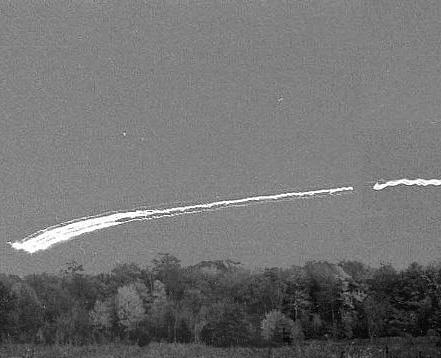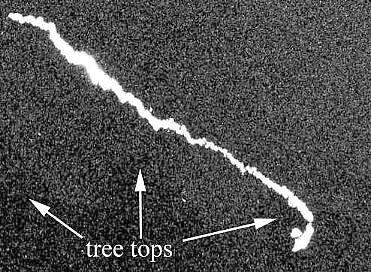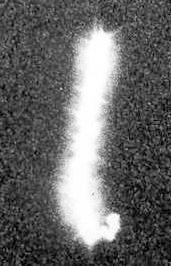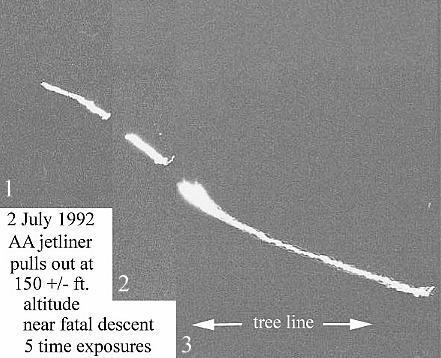Spectacular Pictures of an American Airlines Jetliner Making an
Erroneous Landing Attempt in a Farmers Field,
Nine Miles from the Airport
on 2 July 1992.
[Javascript enhanced]
Only because of the pilot's quick thinking at the last second was he able to aborted the landing attempt and avoid a catastrophic crash into a forest.
Witnessed by Bruce Cornet, Fred Brock, and Ellen Crystall.
Location: West Searsville Rd., Montgomery, NY.
Photographed by Bruce Cornet.
Time interval at that location: 10:48 pm to 11:49 pm.
 |
The sound bite linked to the above images comes from a similar incident on 13 July 1992, just 11 days later. That incident involved a Flying Triangle that mimicked the initial flight path of the American Airlines jetliner, which was in trouble. Just prior to the AA jetliner incident, several anomalous lights had appeared above the tree line towards which the jetliner headed. Those lights either disappeared behind the trees or blinked out not long before the jetliner flew into the area northwest of Stewart International Airport. One spectacular ascent of a brilliant light occurred between 11:06 pm and 11:07 pm. That event is the subject of The Ascent web page. The AOP slowly ascended at a 45 degree angle from below the tree line,

then ascended vertically as its main light brightened considerably to produce an image on the 3200 ISO B&W film that looks like a caterpillar. Finally it flew off in a southerly direction once it reached an altitude of about 190-200 feet, an altitude below which the American Airlines jetliner descended.

Description of the Jetliner Event
A set of lights to what appeared to be a commercial jetliner appeared in the night sky to the northeast of the location where Bruce Cornet, Fred Brock, and Ellen Crystall were standing. The lights turned towards the location where the witnesses had seen some AOP activity just minutes before. Instead of flying due South towards Stewart International Airport, the aircraft seemed to be making a wide loop west so that it could approach the main runway at Stewart from the west (runway 270). But as it approached the AOP hotspot area, the aircraft began to descend. The sequence of the first three time exposures taken by Cornet show his camera being tilted more and more downward with each exposure.

At the beginning of the third time exposure the landing lights brighten, perhaps because the aircraft was now directly facing the camera. It soon banked slowly to its left. As it did so, the landing light brightness gradually subsided. By the end of the third time exposure the jetliner was perilously close to the tops of trees. For all intents and purposes, it appeared that the pilot was searching for familiar landmarks. When he saw tree tops being illuminated by his landing lights, he reacted instantaneously by putting the jetliner's engines into full throttle as he raised the nose of the aircraft sharply. The upwards movement of the aircraft lights at the end of the third time exposure shows this maneuver. The witnesses heard the loud roar of jetliner engines (which shook the air) and saw the aircraft slowly rise back up into the night sky, shaking violently as it did so. The tail stabilizer was illuminated, and on it the AA symbol for American Airlines could be seen. Fred had a pair of binoculars with him, and he confirmed that the tail insignia was AA. The jetliner continued to climb to a safe altitude, turning more and more south before heading towards Stewart airport.
A Possible Case of Instrument Failure
What could explain why the pilot would put his aircraft into a descent for landing nine miles from the runway? What could have confused him, or given him a false indication that he was on approach to the runway? The AOP activity that had occurred in the area where the aircraft descended just minutes before might be the culprit. Strong magnetic interference can be produced by this type of anomaly, and has been recorded by Cornet using a proton magnetometer. On one occasion AOP activity in the same area caused his compass to malfunction to the extent that the compass needle pointed in the wrong direction for North. The lights of the AOP might have been numerous enough from the air to appear like runway lights. And the aircraft's instruments might have given a false indication of orientation, such as horizontal.
Whatever the cause, the close association of near tragic events and close encounters with unidentified aerial phenomena (UAP) has been the research topic of Dr. Richard Haines and Ted Roe of the National Aviation Reporting Center on Anomalous Phenomena (NARCAP). They are specifically interested in aviation safety related issues. See aviation safety. Download the PDF at Aviation Safety in America: A Previously Neglected Factor.
If the near catastrophe on 2 July 1992 had anything to do with unusual electromagnetic fluctuations and instrument failure aboard that American Airlines jetliner, the work of Dr. Haines and Ted Roe should be taken very seriously.
Epilog
In October 1993 Cornet and his wife attended a conference on Triassic vertebrates and plants in Albuquerque, New Mexico, sponsored by the New Mexico Museum of Natural History & Science. On 18 October Cornet gave a professional talk entitled, Applications and limitations of palynology in age, climatic, and paleoenvironmental analyzes of Triassic sequences in North America. Later that afternoon he noticed that American Airlines was holding a conference for its pilots and copilots in the same hotel. He struck up a conversation with a pilot who was clearly wearing an AA uniform, and asked him if he had ever flown out of Stewart International Airport. The pilot said, "Yes, I have flown out of that airport many times." Cornet then described the incident that he had witnessed over the farm field on 2 July 1992. When he got to the part about the pilot making an emergency maneuver to prevent the plane from crashing, the pilot's face grew ghostly white and he immediately excused himself. You figure. Did he know the pilot of that jetliner, or could he have been the pilot of that jetliner?
Bruce Cornet, Ph.D.
bcornet@direcway.com
http://www.monmouth.com/~bcornet/
This page was created on 6 January 2002.
Last updated on
05/08/2023
Copyright B. Cornet 2002.
